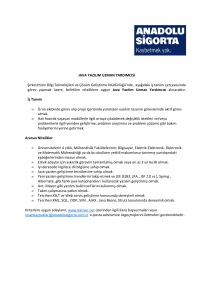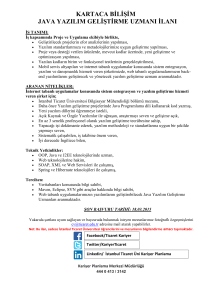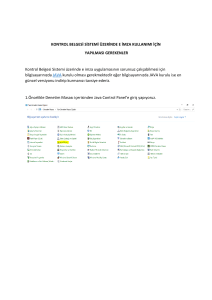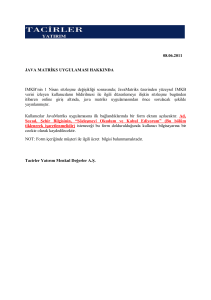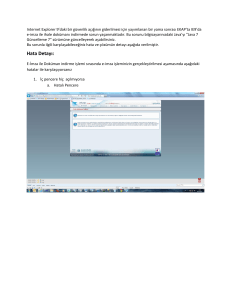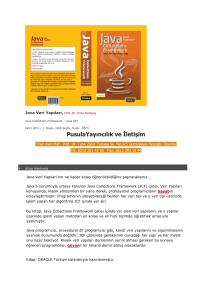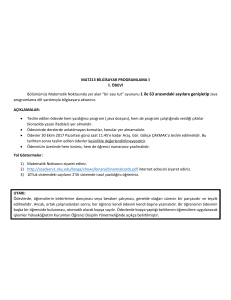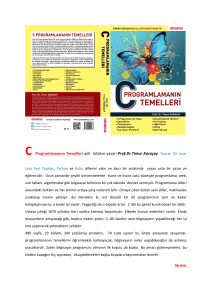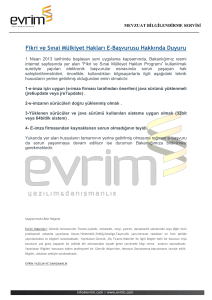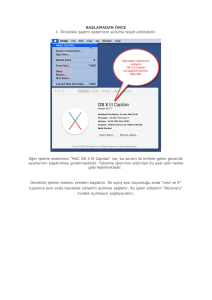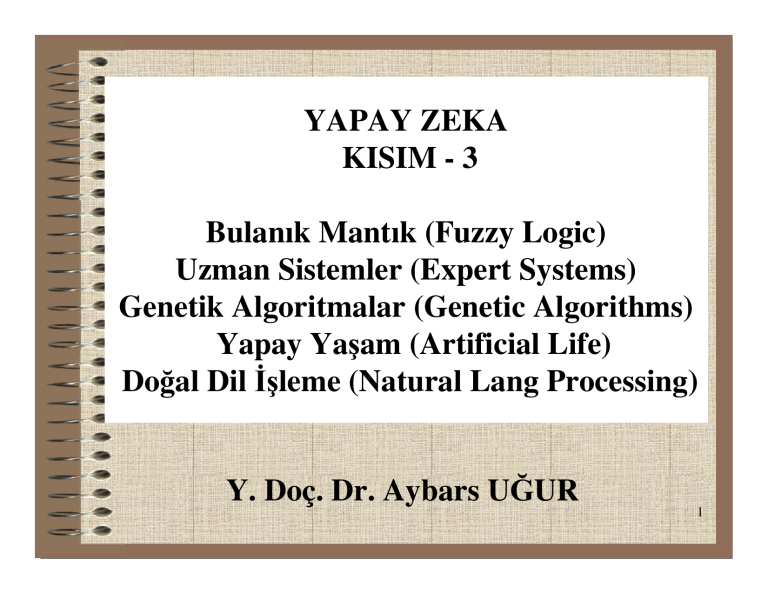
YAPAY ZEKA
KISIM - 3
Bulanık Mantık (Fuzzy Logic)
Uzman Sistemler (Expert Systems)
Genetik Algoritmalar (Genetic Algorithms)
Yapay Yaşam (Artificial Life)
Doğal Dil İşleme (Natural Lang Processing)
Y. Doç. Dr. Aybars UĞUR
1
Bulanık Mantık (Fuzzy Logic)
• Felsefi Yaklaşım
– Kararlar, gerçeklik derecesine dayalı olarak verilir.
– Belirsizlik altında çıkarsama yöntemi değildir.
• Bulanık Olaylar (gerçekler) :
– Imprecise boundaries (kesin olmayan sınırlar)
CA bölgesinde Az sayıda araç var.
• Olasılık
– Incomplete facts (eksik, tamamlanmamış gerçekler)
CA bölgesinde iki araç olabilir.
2
Bulanık Kümeler (Fuzzy Sets)
• Klasik küme teorisi
– Bir nesne kümenin içindedir veya dışındadır.
Keskin olmayan farklılıklardan söz edilemez.
• Bulanık kümelerin sınırları keskin değildir.
– Tamamı ile içinde veya dışında değildir.
6” boyundaki bir kişi 80% uzun kümesi içindedir.
• Bulanık küme teorisi
–
–
–
–
–
Bir nesne belirli derecede bir kümenin içindedir.
1.0 => Kümenin içindedir.
0.0 => Kümenin içinde değildir.
0.0 < nesne < 1.0 => Kümenin kısmen içindedir.
0.35 Üyelik derecesi (Bulanık kümelerde dereceli üyelik tanımını
ilk defa 1965 yılında California Üniversitesinden Prof. Dr. Lütfü
A. Zade yapmıştır.)
3
Bulanık Değişken
Membership
(Degree of Truth)
Meek
-1
1.0
-0.5
0.0
Nasty
Medium
0.5
1
Aggressiveness
4
Bulanık Küme İşlemleri
Tamamlayıcı (Değil)
Üyelik
FS
1.0
¬FS
0.0
Olma derecesi = 1.0 – Olmama derecesi
5
Bulanık Küme İşlemleri
VE
Üyelik
1.0
Yaklaşık 1.80
Uzun
A ifadesinin güven derecesi x, B
ifadesinin güven derecesi y ise A ve
B’nin nedir?
Örnek : How much faith in “that person is
about 1.80 high and tall”
0.0
Uzunluk
6
Bulanık Küme İşlemleri
VE
Üyelik
1.0
Yaklaşık 1.80
Uzun
Yaklaşık 1.80
ve uzun
0.0
Uzunluk
7
Bulanık Küme İşlemleri
VEYA
Üyelik
1.0
Yaklaşık 1.80
Uzun
Yaklaşık 1.80
veya uzun
0.0
Height
8
Bulanık Kurallar (Fuzzy Rules)
• If our distance to the car in front is small,
and the distance is decreasing slowly, then
decelerate quite hard.
• Bulanık değişkenler Mavi
• Bulanık kümeler Kırmızı
• Durumlar, bulanık kümeler içinde.
9
Bulanık Denetim Sistemi
• Matematiksel Modeli Bilinmeyen
Sistemlerde etkilidir.
• Bulanık Denetleme üç aşamada yapılır :
– Bulanıklaştırma (fuzzification)
– Bulanık Sonuçlandırma
– Durulaştırma (defuzzification)
Bulanık niceliği kesin niceliğe dönüştürme
işlemi : Karar verilip seçim yapılır.
10
Bulanık Mantık
Yaygın Kullanım Alanları
• Fotoğraf ve çamaşır makinelerinde,
klimalarda, baraj kapağı kontrolünde,
• Otomatik iletim ve üretim hatlarındaki
ürün kalitelerinin denetiminde,
• Havacılık ve uzay araştırmalarında,
• Robotlarda.
11
Uzman Sistemler
(Expert Systems)
• Uzman Sistem, belirli bir konuda uzman
bir kişinin yapabildiği düşünme ve karar
verme işlemlerini modelleyen yazılım
sistemidir.
• Problemlere uzman bir kişinin getirdiği
şekilde çözümler getirebilen bilgisayar
programlarıdır.
12
Uzman Sistemler
Yaygın Uygulama Alanları
• Tıp ve Askerlik
• Mühendislik ve CAD
• Endüstri (Üretim hatalarının ve arızaların
belirlenmesi)
• İş ve Süreç Planlama
• Ekonomik Analizler
13
Çok Bilinen Uzman Sistemler
• DENDRAL (Molekül yapılarının
belirlenmesi).
• MYCIN (Tıp alanında, bakteriyolojik ve
menenjitik hastalıkların tedavisine yönelik
bir sistem).
• PROSPECTOR (Maden arama
çalışmalarında).
14
Uzman Sistem Kabukları
• Son
zamanlarda
uzman
sistemlerin
geliştirilmesinde uzman sistem kabuklarından
“expert system shell” yaralanılmaktadır. Bu
kabuklar, bir karar mekanizması, boş bir bilgi
tabanı,
kullanıcı-sistem
arayüzü,
bilgi
mühendisinin kullanabileceği bir US geliştirme
biriminden oluşur.
• Örnek : CLIPS, Leonardo ve Kappa.
15
Belirsizlik Altında Çıkarsama
• Uzman sistemlerde bilgi temsilinde
genelde IF-THEN kuralları, frame’lerle
birlikte kullanılır.
• Belirsizlik altında çıkarsama yapmak için
olasılık teorisinden yararlanılır.
• Bayes Teoremi.
16
Avantaj ve Dezavantajlar
17
Genetik Algoritmalar
(Genetic Algorithms)
• Tanım
Genetik Algoritmalar, doğal seleksiyon ve genetik
kuralları üzerine kurulmuş arama algoritmalarıdır
(Goldberg – 1989).
• Yeri
Genetik Algoritmalar, yapay zekanın hızlı gelişen
alanlarından birisi olan evolutionary computing
kapsamına girmektedir.
18
Genetik Algoritmalar (Yöntem)
• Bir probleme olası pek çok çözümün
içerisinde en uygununu (en iyisini)
bulmaya çalışan algoritmalardır.
• Popülasyon nesilden nesile geliştikçe kötü
çözümler yok olma, iyi çözümler ise daha
iyi çözümler oluşturmak için kullanılma
eğilimindedirler.
19
Genetik Algoritmalar ve
Genetik Programlama
• Genetik Algoritmalar (Genetic Algorithms) (GA) John
Holland tarafından bulunmuş; kendisi, öğrencileri ve
arkadaşları tarafından geliştirilmiştir. Holland‘ın "Adaption in
Natural and Artificial Systems" adlı kitabı 1975 yılında
yayınlanmıştır.
• 1992 yılında John Koza belirli işleri yaptırmak için geliştirdiği
programlarda genetik algoritmalar kullanmıştır. Yöntemine
Genetik Programlama "genetic programming" (GP) adını
vermiştir. LISP programs were used, because programs in this
language can expressed in the form of a "parse tree", which is
the object the GA works on.
20
Biyolojik Terimler - I
• Tüm canlılar hücrelerden oluşur. Her hücrede aynı kromozom
(chromosomes) dizisi vardır. Kromozomlar DNA stringleridir ve
tüm organizmanın modelidir. Bir kromozom, gen (genes) adı
verilen DNA bloklarından oluşur. Her gen gözlerin rengi gibi bir
niteliği kodlamada kullanılır. Possible settings for a trait (e.g.
blue, brown) are called alleles. Her genin kromozomda locus adı
verilen belirli bir yeri vardır.
• Complete set of genetic material (all chromosomes) is called
genome. Particular set of genes in genome is called genotype.
The genotype is with later development after birth base for the
organism's phenotype, its physical and mental characteristics,
such as eye color, intelligence etc.
21
Biyolojik Terimler - II
• Reproduction
During reproduction, recombination (or crossover)
first occurs. Genes from parents combine to form a
whole new chromosome. The newly created
offspring can then be mutated. Mutation means that
the elements of DNA are a bit changed. This
changes are mainly caused by errors in copying
genes from parents.
• The fitness of an organism is measured by success
of the organism in its life (survival).
22
GA Operatörleri
• Çaprazlama ve Mutasyon
Çaprazlama
ve
Mutasyon,
Genetik
Algoritmanın en önemli kavramlarıdır ve
performansı özellikle bu iki operatör belirler.
23
Bir Kromozomun Kodlanması
• Kromozom temsilinde genelde “Binary
String’ler” kullanılır.
Kromozom 1 : 1101100100110110
Kromozom 2 : 1101111000011110
Algorithm begins with a set of solutions
(represented by chromosomes) called
population. Solutions from one population
are taken and used to form a new population.
24
Çaprazlama (Crossover) - I
Kromozom 1
11011 | 00100110110
Kromozom 2
10010 | 11000011110
Sonuç Birey 1
11011 | 11000011110
Sonuç Birey 2
10010 | 00100110110
Crossover operates on selected genes from parent
chromosomes and creates new offspring. The
simplest way how to do that is to choose randomly
some crossover point and copy everything before
this point from the first parent and then copy
everything after the crossover point from the other
parent.
25
Çaprazlama (Crossover) - II
• Single point crossover
11001011+11011111 = 11001111
• Two point crossover
11001011 + 11011111 = 11011111
26
Çaprazlama (Crossover) - III
• Uniform crossover
11001011 + 11011101 = 11011111
• Arithmetic crossover
11001011 + 11011111 = 11001001 (AND)
27
Mutasyon (Mutation) - I
Orijinal Birey 1
1101111000011110
Orijinal Birey 2
1101100100110110
Birey 1 (Mutasyon) 1100111000011110
Birey 2 (Mutasyon) 1101101100110110
In case of binary encoding we can switch a
few randomly chosen bits from 1 to 0 or
from 0 to 1.
28
Mutasyon (Mutation) - II
• Olası çözüm çeşitliliği az olabilir.
• Mutasyon reproduction ya da crossover
sırasında gerçekleşebilir.
• Mutasyon olasılığı çok düşük tutulmalıdır
(0.001% gibi).
• Yüksek m değeri uygun string’leri de
bozacak ve GA, çalışması sırasında
problemlerle karşılaşacaktır.
29
Outline of the Basic Genetic Algorithm
1.[Start] Generate random population of n chromosomes (suitable solutions
for the problem)
2.[Fitness] Evaluate the fitness f(x) of each chromosome x in the population
3.[New population] Create a new population by repeating following steps
until the new population is complete
1.[Selection] Select two parent chromosomes from a population
according to their fitness (the better fitness, the bigger chance to be
selected)
2.[Crossover] With a crossover probability cross over the parents to
form new offspring (children). If no crossover was performed, offspring
is the exact copy of parents.
3.[Mutation] With a mutation probability mutate new offspring at each
locus (position in chromosome).
4.[Accepting] Place new offspring in the new population
4.[Replace] Use new generated population for a further run of the algorithm
5.[Test] If the end condition is satisfied, stop, and return the best solution in
current population
30
6.[Loop] Go to step 2
Genetik Algoritmaların
Bazı Özellikleri
• Bir GA genelde 50 ile 500 arasında yineleme
yapar.
• GA stokastik bir arama yöntemidir (SA).
• GA deterministik değil “probabilistic’tir”
(Randomization tekniklerine uyar).
• Aynı anda birden çok noktada çözüm
aradıklarından yapıları gereği paralel çalışan
algoritmalardır.
31
Basit Bir GA Örneği
•
•
•
•
•
•
•
l (string uzunluğu) = 8,
f(x) = x bit string’indeki 1’lerin sayısı,
n (popülasyon büyüklüğü) = 4,
pc=0.7,
pm=0.001
İlk rastgele oluşturulmuş popülasyon şöyle olacaktır:
Kromozom etiketi Kromozom dizisi
Fitness
A
00001100
2
B
11101110
6
C
00100000
1
D
00110100
3
32
GA : Uygulama Alanları
• Optimizasyon
• Otomatik
Programlama
• Makine Öğrenmesi
(Yapay Sinir
Ağlarında öğrenmeyi
sağlayan ağırlık
hesaplamaları,
robotlar)
•
•
•
•
Ekonomi
Tıp
Ekoloji
Sosyal Sistemler
(Böcek Kolonileri,
Çok etmenli
sistemlerde işbirliği)
33
Yapay Yaşam (Artificial Life)
• Çalışma alanı doğal yaşamdır.
• Doğal,
yaşayan
sistemlerin
davranışsal
özelliklerini sergileyen insan yapımı sistemler
üzerine çalışmalardır. (C. G. Langton)
• Amaç : Doğal yaşamdaki temel dinamik
prensipleri anlayarak bunları başka bir fiziksel
ortam olan bilgisayarlar üzerinde tekrar
oluşturmak, deneysel işlemler ve testler için
ulaşılır hale getirmektir.
34
Uygulama Alanları
•
•
•
•
•
Sanal Gerçeklik
Robotbilim
Trafik
Eğitim
Eğlence (Simcity, ...)
•
•
•
•
Askerlik
Uzay
Tıp
Endüstriyel imalat birleştirme
• Mühendislik
35
Cellular Otomata
• Cellular Otomata, Yapay yaşamın bir alt kümesidir.
• “Von Neumann” tarafından 1950’lerde ortaya atılmıştır.
• “The Game of Life”, John Horton Conway tarafından
ortaya atılmıştır. Conway’in “cellular” otomatasında
sadece iki durum söz konusudur : bir hücre ya canlıdır
veya ölüdür. Hücreler basit içsel kuralları takip ederler.
Conway büyüme veya ölme eğilimlerinin dengelenmesini
sağlamıştır.
36
Yapay Yaşamda
Kullanılan Bazı Yöntemler
• Yapay Sinir Ağları
• Genetik Algoritmalar
Etmenler ve Yapay Yaşam Simülatörleri
37
Karınca Kolonisi Optimizasyonu
• Karıncalar yiyecek kaynaklarından yuvalarına
olan en kısa yolu herhangi görsel ipucu
kullanmadan bulabilme yeteneğine sahiptirler.
• Karıncalar ilerlerken, belirli bir miktar “feromon”
depo ederler ve olasılığa dayanan bir yöntemle
“feromon”un daha çok olduğu yolu az olduğu
yola tercih ederler.
38
Yapay Karıncalar
Karınca tabanlı algoritmalarda temel fikir, basit
iletişim mekanizmalarını kullanan yapay akıllı
etmenlerin, bir çok karmaşık problem için çözümler
üretebilmesidir.
Karınca Kolonisi problemleri :
Traveling Salesman Problem (TSP)
...
39
Doğal Dil İşleme
• Doğal Dil Anlama (Natural Lang. Understanding)
Belirli amaçlarla söylenen ve yazılan cümleleri
anlama ile ilgilidir.
• Doğal Dil Üretme (Natural Lang. Generation)
(Tam tersi) Söylenmek istenenleri, Türkçe veya
İngilizce gibi doğal bir dil ile temsiliyle ilgilenir.
40
Doğal Dil Anlama
41
Doğal Dil Anlamanın 4 Aşaması
• Speech Recognition (Ses Tanıma)
İşlenmemiş ses sinyalleri analiz edilerek,
konuşulan kelime dizisi elde edilir.
• Syntactic Analysis (Sözdizimsel Analiz)
Dilin gramer bilgisi kullanılarak kelimeler
analiz edilir ve cümle yapısı elde edilir.
42
Doğal Dil Anlamanın 4 Aşaması
• Semantic Analysis (Anlam Analizi)
Cümle yapısından ve içindeki kelimelerin
anlamından yararlanılarak tüm cümlenin
kısmi anlamı elde edilir.
• Pragmatic Analysis (Pragmatik Analiz)
Genel durum yani şartlara bakılarak
cümlenin anlamı tamamlanır. Kim, ne
zaman, nerede kime dedi gibi.
43
Konuşmacı Tanıma
• Konuşmacı Saptama (Identification)
• Konuşmacı Doğrulama (Verification)
Computer Vision ve diğerleri...
44
Some Java Tools
http://www.developer.com/java/article.php/10922_1475381_2
•
•
•
•
•
JOONE
JESS
FuzzyJ
JTP
JADE
45
JOONE (Java Object Oriented Neural Engine)
• Joone is a neural net framework written in Java. It's
composed by a core engine, a GUI editor and a
distributed training environment and can be extended by
writing new modules to implement new algorithms or
architectures starting from base components
• http://sourceforge.net/projects/joone
• http://www.jooneworld.com/
46
JESS (Java Expert System Shell)
This tool is a commercial one but the binary file can be downloaded for
free. This is a popular tool for building Expert Systems and Knowledge
Base in Java. JESS has its own rule-language and it uses Backwardchaining reasoning. Note that the Java Rule Engine API from JSR-94
has a wrapper for JESS. Java Rule Engine has no rule-language of its
own therefore it can rely on JESS for rule-language. JESS is a very
important tool that can tie or link with other tools. You can extend it and
incorporate other machine learning tools into it with less effort. There is
no one solution for machine intelligence that solves all and it is a
common practice to combine (hybridise) one or more methodologies, the
more the better. Example, Protigi + JADE + JESS has been integrated
well in Protigi. Fuzzy Logic can be incorporated into JESS through
FuzzyJESS. It is also possible to integrate ANN (Artificial Neural
Network), BBN (Bayesian Belief Network), CBR (Case-BasedReasoning) and GA (Genetic Algorithm) into FuzzyJESS. The resulting
hybrids of different machine learning methodologies would make a killer
application (Java Rule Engine + JESS + Protigi + JADE + FuzzyJESS +
ANN + BBN + GA + CBR). http://herzberg.ca.sandia.gov/jess/
47
FuzzyJ ToolKit (for the Java(tm) Platform)
& FuzzyJess
• The NRC FuzzyJ Toolkit from the National Research Council of
Canada's Institute for Information Technology is a set of Java(tm)
classes that provide the capability for handling fuzzy concepts and
reasoning. It is hoped that this proves useful for exploring the ideas of
fuzzy logic and fuzzy reasoning in a Java setting. Much of the work is
based on earlier experience building the FuzzyCLIPS extension to the
CLIPS Expert System Shell. The toolkit's API can be used standalone
to create fuzzy rules and do reasoning, however, it can also be used
with Jess, the Expert System Shell from the Sandia National
Laboratories. The integration with Jess, FuzzyJess, provides a
capability that is similar to but in many ways more flexible than
FuzzyCLIPS.
• This work is currently at version 1.5a (NEW as of May 23, 2003).
Future versions will be possible to maintain and follow Jess revisions
with minimal effort since the integration with Jess has been carefully
planned with the Jess author.
• http://ai.iit.nrc.ca/IR_public/fuzzy/fuzzyJToolkit.html
48
• http://www.iit.nrc.ca/IR_public/fuzzy/fuzzyJToolkit2.html
Java Theorem Prover (JTP)
• JTP is an object-oriented modular reasoning system developed by
Gleb Frank in Knowledge Systems Laboratory of Computer Science
Department in Stanford University. JTP is based on a very simple
and general reasoning architecture. The modular character of the
architecture makes it easy to extend the system by adding new
reasoning modules (reasoners), or by customizing or rearranging
existing ones.
• The system is implemented in Java. The reason for this choice is that
Java is ideally suited for easy integration of object-oriented systems,
which facilitates both extending JTP's functionality and embedding
JTP in other systems. The abundance of supplementary software
available in Java also helps.
• http://ksl.stanford.edu/software/jtp/
49
Java Agent DEvelopment Framework
(JADE)
• JADE (Java Agent DEvelopment Framework) is a software
framework fully implemented in Java language. It simplifies the
implementation of multi-agent systems through a middle-ware that
complies with the FIPA specifications and through a set of graphical
tools that supports the debugging and deployment phases. The agent
platform can be distributed across machines (which not even need to
share the same OS) and the configuration can be controlled via a
remote GUI. The configuration can be even changed at run-time by
moving agents from one machine to another one, as and when
required. JADE is completely implemented in Java language and the
minimal system requirement is the version 1.4 of JAVA (the run time
environment or the JDK).
• http://sharon.cselt.it/projects/jade/ JADE 3.2 has been released.
http://www.fipa.org/ Foundation of Intelligent Physical Agents
(FIPA) homepage
50
Other Java Tools
• http://www.w3.org/2001/sw/ Semantic Web homepage
• http://www.w3.org/RDF/ RDF homepage
• http://www.jcp.org/jsr/detail/94.jsp Java Rule Engine (JSR-94)
• http://www.jcp.org/jsr/detail/87.jsp Java Agent Services (JSR-87)
• http://www.jcp.org/jsr/detail/73.jsp Java Datamining API (JSR-73)
• http://protege.stanford.edu/index.html Protigi-2000 Java Tool for building Knowledge Base& Ontology
• http://leap.crm-paris.com/ Lightweight Extensible Agent Platform (LEAP)
• http://www.ai.sri.com/~oaa/ Open Agent Architecture
• http://research.compaq.com/SRC/esc/Simplify.html Automatic Theorem-Prover called Simplify
• http://sourceforge.net/projects/aglets/ AGLET (Tool for development of mobile Multi Agents Systems)
• http://www-2.cs.cmu.edu/~javabayes/Home/ JavaBayes (Bayesian Belief Network for Java)
• http://www.daml.org/ DAML (DARPA Agent Markup Language) homepage
• http://www.markwatson.com/ (Mark Watson) Lots of Java Sample Codes for Machine Intelligence in
this author's homepage (refer book item 2 on the book lists)
• http://sourceforge.net/projects/selectionengine/ Selection Engine is a Java Case-Based-Reasoning Tool
51
Other Platforms
• Linux : www.ibiblio.org/pub/Linux/docs/ HOWTO/otherformats/pdf/AI-Alife-HOWTO.pdf
• .NET ve C# : http://www.thecodeproject.com/csharp/#Network
http://franck.fleurey.free.fr/NeuralNetwork/index.htm
http://www.csharphelp.com/archives2/archive407.html
• MATLAB Neural Network Toolbox: http://www.mathworks.com/
http://www.mathworks.com/products/neuralnet/
• Neural Networks and Mathematica :
http://www.wolfram.com/products/applications/neuralnetworks/
• NN Tools & Utilities : http://www.makhfi.com/tools.htm
http://www.xasa.com/directorio/mozilla/Top/Computers/Artificial_In
telligence/Neural_Networks/Software/
52
EK 1
HILL CLIMBING ALGORITHM
53
EK 2
SIMULATED ANNEALING ALGORITHM
54
EK 3
GENERIC SEARCH ALGORITHM
Path search(start, operators, is_goal) {
fringe = makeList(start);
while (state=fringe.popFirst()) {
if (is_goal(state))
return pathTo(state);
S = successors(state, operators);
fringe =
insert(S,
fringe);
}
return NULL;
}
Depth-first: insert=prepend; Breadth-first: insert=append
55
EK 4
GREEDY BEST-FIRST SEARCH
ALGORITHM
Path search(start, operators, is_goal) {
fringe = makeList(start);
while (state=fringe.popFirst()) {
if (is_goal(state))
return pathTo(state);
S = successors(state, operators);
fringe =
insert(S,
fringe);
}
return NULL;
}
Order the nodes in the fringe in increasing values of h(N)
56
EK 5
MINIMAX ALGORITHM
57
EK 6
A* ALGORITHM
construct root (=start state)
while front is non-empty do
choose node n with best g+h
remove n from front
if n is not a goal node
expand n
remove “dominated” nodes
end loop
58
EK 7
Tabu Search Algorithm - I
Function TABU_SEARCH(Problem) returns a solution state
Inputs: Problem, a problem
Local Variables: Current,
a state Next,
State BestSolutionSeen,
a state H,
a history of visited states
59
EK 7
Tabu Search Algorithm - II
• Current = MAKE-NODE(INITIAL-STATE[Problem])
• While not terminate
– Next = a highest-valued successor of Current
– If(not Move_Tabu(H,Next) or Aspiration(Next)) then
• Current = Next
• Update BestSolutionSeen
• H = Recency(H + Current)
– Endif
• End-While
• Return BestSolutionSeen
60


